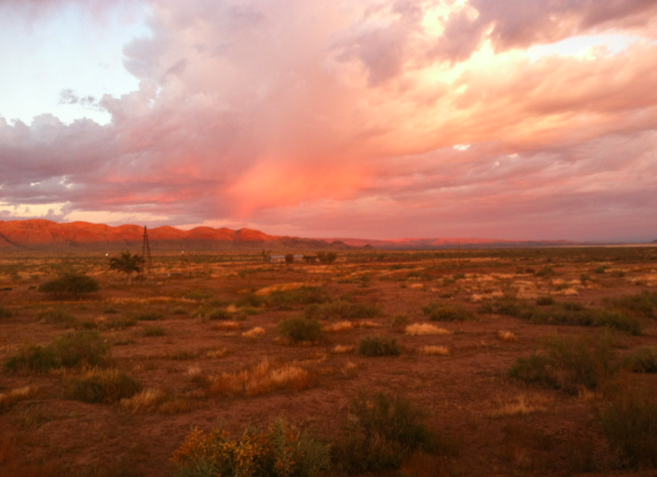
Jim White III
caption: Dawn in the Big Bend of Texas; it shares tectonic and geographic characteristics with the Permian Basin, home of the country\’s highest-producing oil field.
New technologies to get at hard-to-reach oil and gas reserves have already transformed communities and economies from Pennsylvania to eastern Montana. Now those techniques are reaching into formerly pristine corners of the West.
And coming with them are concerns about how ramped up energy production will intersect with the Lone Star state’s long struggle to conserve water.
A case in point;
The Big Bend of Texas is a border region renown for its desert landscapes and tranquility. But parts of the borderland lie on the edges of an ancient seabed laden with hydrocarbons…the oil-rich Permian Basin…the nation’s highest-producing oil field.
And today fracking—blasting water, sand and chemicals into rock to free trapped oil and gas—means once inaccessible oil is there for the taking. And fracking’s coming soon to both sides of this border region.
Juan Jose Suarez Coppel, CEO of Mexico’s state-owned oil monopoly, PEMEX, spoke recently on Bloomberg television.
“Mexico has huge potential in hydrocarbons,” he said when asked about short term prospects for PEMEX.
PEMEX is drilling a series of exploratory wells on its side of the Texas border—a prelude, it says, to industrial-scale fracking all along the U.S.-Mexico border.
And the fracking momentum is disturbing some Texas residents.
At a recent city council meeting in Alpine, Texas, gateway to the Big Bend and about 80 miles from the border, residents railed against the possibility that fracking will take place in the area.
One resident, Oscar Cobos urged city council to ban fracking. He strode up to the lecturn, visibly upset.
“If they’re ready to sell us out on a silver platter we don’t need them in office,” he said referring to council members.
Another resident, Jan Woodward, said too much is at stake in a region that celebrates its remoteness.
“We don’t want to change our lifestyle in Alpine, Texas,” she testified.
The city council here took no action.
But in the north Texas town of Denton, activists have managed to get a fracking ban on the November ballot. This is all new legal ground in Texas.
Right now, it’s the the state, and not local or county government, that regulates the oil and gas industry here.
Cities in other states have tried–with limited success–to stop fracking. Courts in Pennsylvania and New York have ruled in favor of allowing cities some local control when it comes to fracking.
But in Colorado, the courts have just ruled against a fracking ban in the city of Longmont. That decision expected to be front and center when voters consider anti-fracking ballot initiatives in Colorado in November.
Which brings us back to Alpine, and a rancher named Howdy Fowler.
“What I know about fracking you could put in a thimble,” he told a reporter.
Fowler was the one person at the Alpine council meeting who spoke out against a fracking ban. And he’s got a more traditional Texas attitude on the issue.
“I’m not an expert on fracking,” he continued.
“But when people start telling you what you can and can’t do with your own property, you’re treading on thin ice.”
Fracking has propelled the economies of cities farther away from the border— like Midland and Odessa, in the heart of the Permian Basin.
But it’s a more nuanced argument in border counties.
They’re watching the oil and gas play creep closer to an area in the midst of the worst drought in its history.
In the last two years, more than 100 fracking wells have been permitted in one Texas border county alone. And fracking doesn’t take place without water.
A single fracking well can use a million gallons of water. And a well can be reused 20 times.
The chief elected official in the border county of Presidio, Paul Hunt, told Inside Energy that he is concerned that this area—a place where drought has seriously damaged the lone industry here, cattle—can handle fracking.
“Water in our aquifers is something that we need to be a whole lot more aggressive about protecting,” he said.
Fracking is creating a seller’s market for water here. One example: The City of Marfa, the seat of Presidio County, is selling water to oil and gas interests. That’s prompted some residents to block access to fire hydrants—where water tankers are forced to return later to draw the water.
The city defends the sale, saying it has excess supply and that oil and gas customers pay almost 6 times more for their water than residents do.
“We monitor wells and they are not dropping,” said Janet Adams, manager of the Underground Water Conservation District in Jeff Davis County, north of Marfa, Texas. She is also selling water, again like Marfa, with a high markup for commercial customers.
Adams dismisses water loss concerns, describing one rancher’s decision to sell water.
“If he over-pumps it, it hurts him more than anybody,” she said. “And west Texas landowners are not going to hurt their own land and property.”
It’s too soon to suggest that there’s mounting momentum for fracking bans in the border region. That could change, though. Despite this state’s long love affair with oil and gas — a recent University of Texas poll found the majority of residents here say — fracking needs more regulation.








